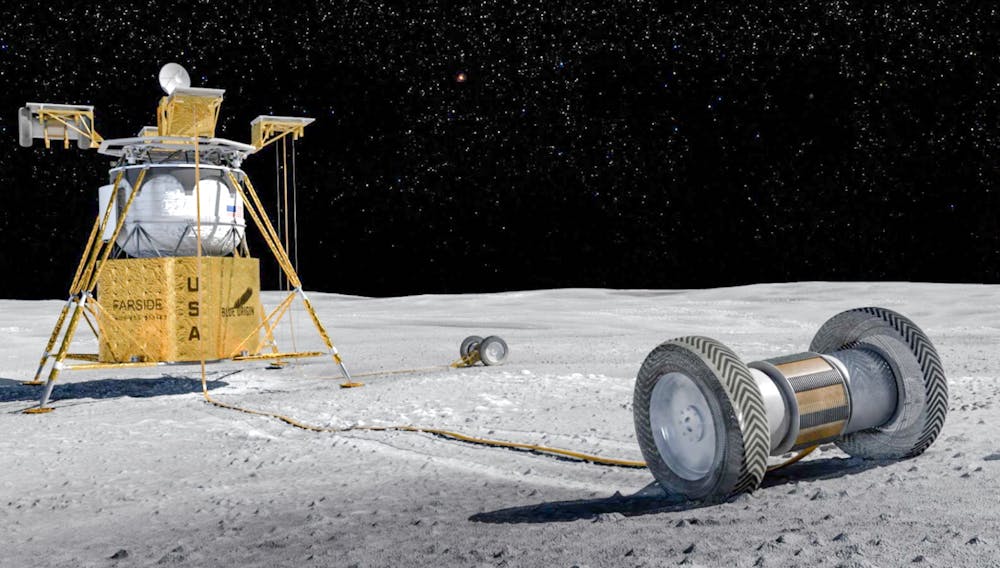Assistant Professor of Physics Jonathan Pober was recently awarded NASA’s Nancy Grace Roman Technology Fellowship in Astrophysics to advance his work on a groundbreaking lunar telescope.
Pober is one of six early-career researchers across the United States to receive this award, according to a NASA press release. Meenakshi Narain, chair of physics, wrote in an email to The Herald that the department is proud of Pober’s achievements and believes “this new and prestigious award will allow Professor Pober to develop a long-term vision for the field of astrophysics, and establish himself as (a) future leader of innovative large projects at NASA.”
Pober’s work on the NASA-funded radio telescope will offer new ways to answer questions related to the cosmological dark ages, or the period between the Big Bang and the first star formation, Pober said. This period — during which there was no light in the universe, only hydrogen and some helium — has been completely unstudied because scientists do not yet have a telescope to see it, he added.
Because the early universe almost exclusively contained hydrogen, scientists need a way to observe the non-visible light — or long radio waves — hydrogen emits to study this time period. The researchers are designing a special type of space telescope called a radio telescope to capture these waves, which can help fill large gaps in researchers’ knowledge about the history of the universe, Pober said.
Pober has experience using radio telescopes on Earth, but the planet’s atmosphere limits him and other researchers’ ability to view these long radio waves. For this reason, Pober and his team are designing a radio telescope that can be autonomously assembled and deployed on the far side of the moon.
The challenge of this project is to “balance the need for something we can actually build with something that can actually do the science,” he said. “Having an antenna that a rover can autonomously build looks a lot different than an antenna you would build here on earth, where you can actually have a team of people assemble it.”
With funding from NASA, the researchers are testing various telescope designs that will allow them to build the telescope in space.
With the NASA funding, Pober and his team will be able to simulate data for several telescope designs and then determine which design is optimal for their work. Willow Smith GS, a PhD student on Pober’s team, is debugging the simulation code to ensure that it works. Once completed, “we’ll start producing actual simulated data,” Smith said.
Narain noted her appreciation for the opportunities this funding will open up for undergraduates, graduate students and postdocs in the study of physics and new technologies.
Over the course of this decade, the team’s focus will shift to building smaller telescopes on the far side of the moon which will look for extrasolar planets around other stars and analyze their radio signals.
“With these experiments, scientists will be able to understand the interaction between stars and planets and their magnetic fields, and how that might lead to a hospitable or inhospitable environment for life,” Pober said.
Pober believes that in 10 years, scientists will have a few hundred antennas on the far side of the moon, and perhaps by the 2030s or 2040s, a large array of thousands. “If (an array of telescopes) gets built in the next three decades, I would call that an achievement,” he said.
After the telescopes are built, scientists will be able to view the long radio waves they are looking for, which will help answer long-standing questions, including about the origins of the universe and the nature of dark matter, Pober said.
According to Pober, this is a very “large-scale and ambitious project.”
But in the meantime, “we have to show that we can operate smaller-scale experiments and get good science out of them before we can build a really big thing that can do cosmology and answer the big questions,” he said.
For Pober, receiving this award feels not only exciting, but also reassuring. It means “NASA is taking this project seriously,” and that the science his team is working on is exciting enough to make it “worth continuing investigations and thinking about how to turn the telescope array into a reality,” he said.





